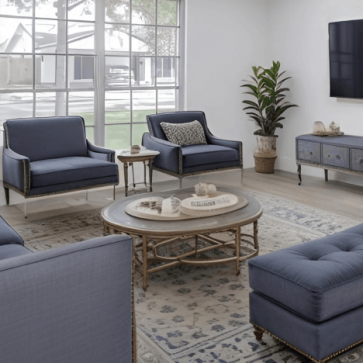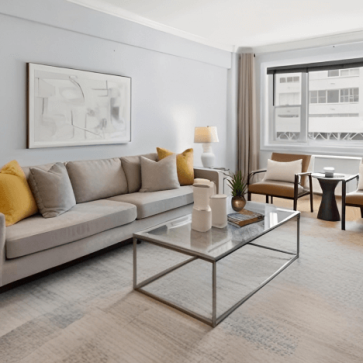Interior design has always been a blend of art and precision, where creativity meets functionality. For years, designers have relied on traditional methods—meticulous planning, mood boards, and hands-on expertise—to craft stunning spaces. But with the rise of artificial intelligence, a new contender has entered the arena: AI-powered room planners, bringing about endless discussions on AI vs. traditional room design.
These digital tools promise effortless visualization and customization, revolutionizing how we approach interior design. But do they truly surpass the human touch, or is there still unmatched value in traditional design methods? Let’s dive into the advantages and limitations of both to determine which approach best suits your design vision.
Traditional Room Design: A Personalized, Human Approach

Traditional interior design has been the standard for decades, relying on the expertise of professional designers to transform spaces. This process typically involves in-depth consultation, collaboration, and custom solutions tailored to the client’s needs and preferences.
Here are some key advantages and challenges of traditional room design when talking about AI vs. traditional room design:
Pros
personalized experience
The most significant benefit of traditional interior design in the talks about AI vs. traditional room design is the highly personalized, human touch. A professional designer can take the time to understand your specific vision, preferences, and lifestyle needs. They can offer design suggestions based on years of experience and expertise, making sure your space is both beautiful and functional.
creative solutions
Designers can think outside the box and suggest creative solutions that are tailored to the unique characteristics of your home. They can incorporate architectural elements, furniture, and color schemes that are truly one-of-a-kind, often giving your space a bespoke feel.
hands-on expertise
A professional designer can visit your home, assess the space, and provide hands-on guidance. They can help with challenging layouts, ensuring that every piece fits perfectly and that the space feels cohesive.
access to the resources of the trade
Experienced interior designers have access to high-quality materials, exclusive furniture pieces, and unique decor that you may not find in retail stores. With AI vs. traditional room design in mind, this access gives them an edge in sourcing rare and high-end items that elevate your room’s design.
Cons
high cost
Hiring a professional interior designer can be expensive, especially if the project involves full-service design, consultations, and purchasing furniture or materials. For those on a budget, this can be a significant drawback, a deal-breaker even…
time-consuming
Comparing AI vs. traditional room design, the traditional design process often involves several stages, including brainstorming, design drafts, material selection, and installation. This can take weeks or even months, depending on the complexity of the project.
limited flexibility
Traditional design requires more in-person collaboration, which can limit flexibility. If you want to make changes after finalizing the design, it may be more challenging to do so without additional costs or delays.
AI Room Planners: The Future of Interior Design

AI-driven design tools, such as AI room planners, offer a modern, digital alternative to traditional design methods. These tools use artificial intelligence to analyze your space, generate design ideas, and allow you to visualize and modify the layout in real-time.
Let’s explore the pros and cons of using AI when discussing AI vs. traditional room design:
Pros
speed and efficiency
One of the biggest advantages of using an AI room planner is the speed with which you can design a space. AI tools can generate room layouts, color schemes, and furniture arrangements in minutes. This efficiency makes it an excellent choice for those with tight schedules or budgets.
cost-effective
AI room planners often come at a fraction of the cost of hiring a professional interior designer. Many tools offer free or affordable subscriptions, allowing you to access design capabilities without breaking the bank.
customization and flexibility
AI-driven design platforms offer a high degree of customization when we think about AI vs. traditional room design. You can experiment with different layouts, colors, and furniture pieces, adjusting the design until you find the perfect look. This flexibility is a major advantage for DIY enthusiasts who want to have full control over the design process.
visualization and 3D rendering
With an AI room planner, you can see a 3D version of your room design, which makes it easier to understand how your space will look. This visual feedback allows you to make informed decisions about furniture placement, color schemes, and decor items.
accessibility
AI-powered tools are typically user-friendly and accessible to anyone, regardless of their design expertise. You don’t need to be a professional to create a stylish and functional space, making these tools ideal for beginners and homeowners with limited design experience.
Cons
limited human touch
While AI room planners can generate impressive designs, they may lack the nuance and creativity that a professional designer can offer. AI can’t always understand the emotional or aesthetic elements that a human designer can bring to the table, such as how a space will feel to live in.
over-reliance on templates
Many AI tools rely heavily on pre-designed templates and algorithms, which might limit the uniqueness of your room’s design. While you can experiment with different options, you may find that the results are somewhat generic and lack a truly personal touch.
limited contextual understanding
However, artificial results are not all sunshine and rainbows when comparing AI vs. traditional room design. AI tools may not always account for every unique feature of your home. For example, they may overlook specific lighting conditions, architectural quirks, or how your family uses the space on a day-to-day basis. A professional designer, on the other hand, will consider these factors in their approach.
technical challenges
While AI room planners are becoming more user-friendly, they may still present technical challenges, especially for those unfamiliar with technology. The learning curve for certain platforms could be a barrier for some users.
Which Approach Is Best for You?
The choice between traditional room design and AI-driven tools depends on your specific needs, preferences, and budget.
Here’s a quick hack to help you decide:
Choose traditional room design if…
- You want a highly personalized, hands-on experience with a professional’s expertise;
- You’re working on a high-end project or desire access to exclusive resources and materials, or,
- You value the creative input and unique touch of a professional designer over speed and affordability.
Opt for AI room planners if…
- You’re on a budget and want a cost-effective solution for room design.
- You value speed, efficiency, and the ability to quickly experiment with different design options.
- You enjoy taking a hands-on approach to design and want flexibility in making changes.
To Conclude: Finding the Perfect Fit
In the pit fight of AI vs. traditional room design, both traditional design methods and AI-driven tools offer distinct advantages, each catering to different needs and priorities. If you seek a highly personalized approach with expert guidance, traditional design remains unmatched. On the other hand, if speed, affordability, and flexibility are your top concerns, AI-powered room planners provide an innovative, hassle-free alternative.
The ultimate choice comes down to your vision, budget, and how much you prioritize human creativity versus technological efficiency. Whichever path you choose, the future of interior design is brighter—and smarter—than ever.





